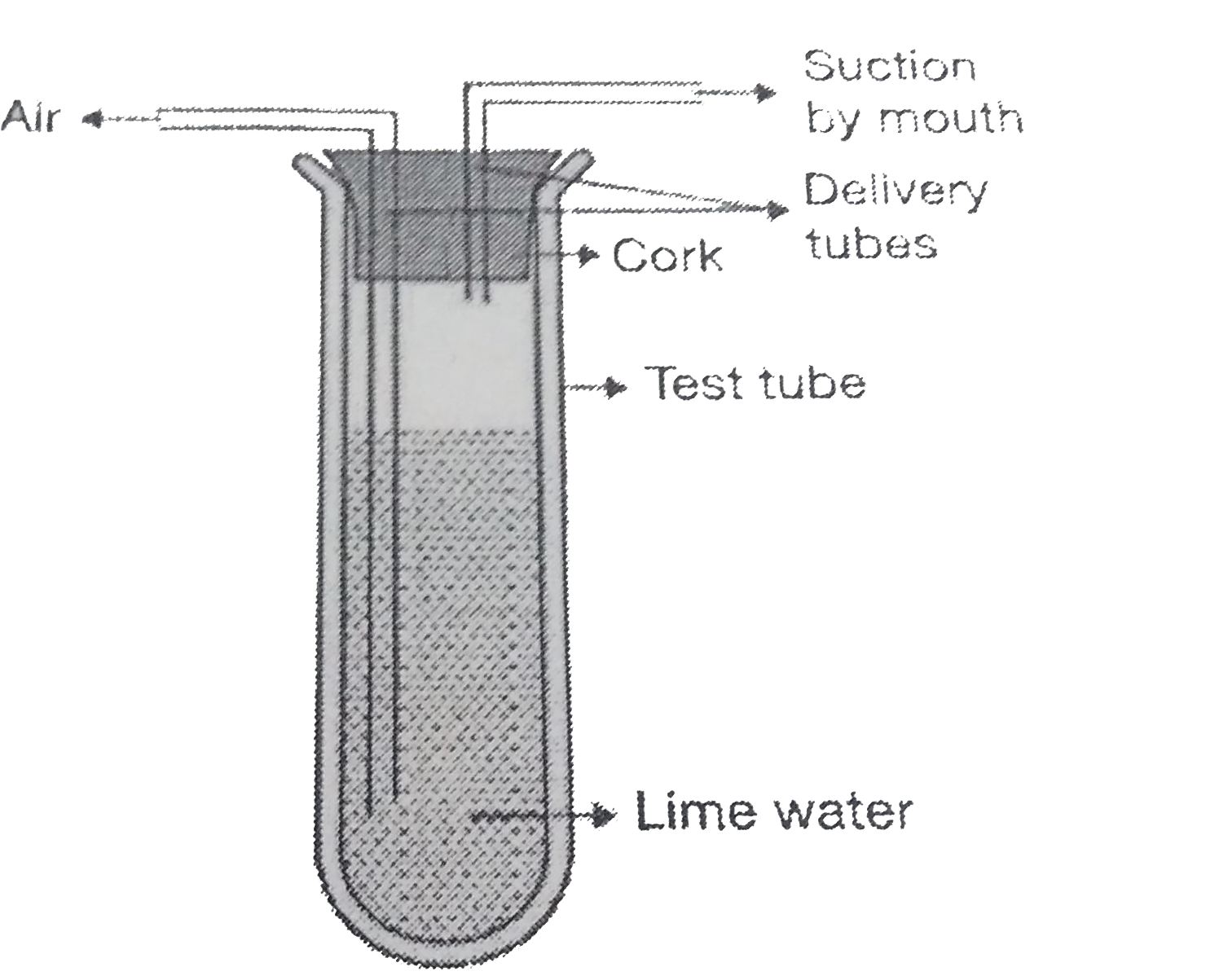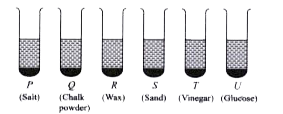Shruti tested the nature of a few common substances with the help of some indicators. Indicators used and changes she observed are as follows:

Substances present in test tubes I, II, III and IV are respectively
Salt solution, curd, lemon juice and vinegar
Orange juice, window cleaner, sugar solution and lime water
Vinegar, soda water, soap solution and lemon juice
Lemon juice, lime water, window cleaner and soap solution.
The correct Answer is:B
From the colour change shown with different indicators, it can be concluded that test tube I contains acidic solution. II contains basic solution, IlI contains neutral solution and IV contains basic solution. Orange juice is acidic, window cleaner is basic, sugar solution is neutral and lime water is basic.
Topper's Solved these Questions
Similar Questions

(a) Write the chemical name of the substance taken in the test tube.
(b) What is the observation ? Give reasons.
( c) The air present in the test tube as shown in the diagram is sucked out . why ?View SolutionSome sugar solution is taken in a test-tube and a little of substance X in powder form is added to it. The mouth of test-tube is closed with a cork and allowed to stand for sometime. On opening the cork, a characteristic smell of substance Y is obtained and a gas Z is also observed to be formed. The gas Z extinguishes a burning matchstick.
(a) What could be (i) X, (ii) Y, and (iii) Z?
(b) What is the process of converting sugar into substance Y by the action of X known as ?
(c) What type of respiration is exhibited by X in the above process ?View Solution
Knowledge Check
- Question 1 - Select One
The following experiment was conducted by class 6 students to check the solubility /miscibility of a few common substance in water .

Which of the following observation is / are correct ?
I. Components will disappear completely in thest tubes P, R and T .
II. Components will form a s eparate layer in test tubes R and U .
III. Components in test tubes Q and S are insolube in water .
IV. Components in test tubes R and T are immiscible in water .AIII onlyBI onlyCI,II and IV onlyDII and IV only - Question 2 - Select One
Sheela designs an experiment to test the effect of solute concentration during osmosis. She takes four equal sized potato cubes having an identical weight and places each cube in four separate test tubes I, II, III, and IV, containing 1%, 2%, 3%, and 4% sucrose concentrations respectively. After one hour, she removes the cubes from the test tubes, blots the pieces with a paper towel, and weighs them to find the final mass of each cube. The solution in test tube Ill was hypertonic to the cytoplasm of the potato cells. What change will be observed in the potato cube of test tube Ill?
AThe final weight of the potato cube will be less than its initial weight.BThe final weight of the potato cube will be more than its initial weight.CThere will be equal movement of water in and out of the potato cube.DThere will be equal movement of sucrose in and out of the potato cube. - Question 3 - Select One
A student was given four unknown solutions in test tubes marked A,B,C and D and asked to test them with universal indicator solution. He observed that on putting universal indicator solution, the solutions A,B,C and D turned blue, orange, green and red respectively. The test tube which contains sodium chloride solution is:
AABBCCDD
Fill in the following blanks with suitable words :
The acidic or basic nature of a substance is tested by using an ……….View SolutionApparatus: Test tube, conical flask, balance, etc.
Chemicals: Sodium chloride and silver nitrate.
Procedure:
i. Take sodium chloride solution in a conical flask and silver nitrate solution in a test tube.
ii. Tie a thread to the test tube and insert it carefully into the conical flask. Make the conical flask air tight by fitting a rubber cork.
iii. Weigh the conical flask with the help of a balance.
iv. Now tilt the conical flask and mix the solution present in the test tube with the solution in the conical flask.
v. Weigh the conical flask again.
Did any insoluble substance form?View SolutionApparatus: Test tube, conical flask, balance, etc.
Chemicals: Sodium chloride and silver nitrate.
Procedure:
i. Take sodium chloride solution in a conical flask and silver nitrate solution in a test tube.
ii. Tie a thread to the test tube and insert it carefully into the conical flask. Make the conical flask air tight by fitting a rubber cork.
iii. Weigh the conical flask with the help of a balance.
iv. Now tilt the conical flask and mix the solution present in the test tube with the solution in the conical flask.
v. Weigh the conical flask again.
Did any insoluble substance form?View SolutionA student appears for tests I. II and III. The student is considered successful if he passes in test I. II or I. III or all the three. The probabilities of the student passing in test I. II and III are m. n and 12 respectively. If the probability of the student to be successful is 12 then which one of the following is correct ?
View SolutionA great scientist "Tom Cat' collected six sample solu tions in six test tubes for a new discovery and tried for Nobel Prize (Chemistry). But his very close friend 'Jerry Mouse' all of a sudden appeared in the laboratory and kicked off AgNO3 bottle on all these samples and spoiled the experiments, making all white precipitates. But "Tom Cat' did not lose his enthusiasm and made the following observations from all the white precipitates formed.
Test tube Observations
(I) The ppt. is soluble on heating. (II) The anion present in test tube II does not give the brown ring test for nitrate if it is present with nitrate ion
(III) The ppt. becomes soluble on addition of excess of solution that was present in test tube III but on heating it produces a black ppt, which does not dissolve in NH3
(IV) The ppt. gives a clear solution with excess of solution that was present in test tube IV and that clear solution gives black metallic ppt. on heating together with evolution of acidic gas which turns acidic K2Cr2O7 solution green.
(V) The aqueous suspension of ppt. produces black metallic residue and an acidic gas on heating. This gas does not turn K2Cr2O7 solution green.
(VI) The ppt. is soluble in NH3 but does not give chromyl chloride test.
View Solution

